
Masham is a market town and civil parish in the Harrogate district of North Yorkshire, England. It had a population of 1,205 at the 2011 census.

Yorkshire Water is a water supply and treatment utility company servicing West Yorkshire, South Yorkshire, the East Riding of Yorkshire, part of North Lincolnshire, most of North Yorkshire and part of Derbyshire, in England. The company has its origins in the Yorkshire Water Authority, one of ten regional water authorities created by the Water Act 1973, and privatised under the terms of the Water Act 1989, when Yorkshire Water plc, the parent company of the Yorkshire Water business, was floated on the London Stock Exchange. The parent company was Kelda Group in 1999. In February 2008, Kelda Group was bought by a consortium of infrastructure funds.

Roundhill Reservoir is situated near Leighton Reservoir in North Yorkshire, England. It was constructed by Harrogate Corporation early in the 20th century. Water from the reservoir is fed into Yorkshire Water's grid.

Stocks Reservoir is a reservoir situated at the head of the Hodder valley in the Forest of Bowland, Lancashire, England. It provides water mainly for Blackpool and the Fylde coast. The reservoir has a fly fishing club which is very popular in the summer months and a small cafe which is popular with walkers. The Board House is a building used for meetings by United Utilities and is located on the western shores of the reservoir, near the Hodder Water Treatment Works. Stocks Reservoir was opened on 5 July 1932 by Prince George, K.G.

Healey is a small village and civil parish in the Harrogate district of North Yorkshire, England. It is situated in the valley of the River Burn, to the immediate west of Fearby. It is about three miles west of Masham in the Nidderdale Area of Outstanding Natural Beauty. There are several holiday cottages and four Grade II Listed buildings, one of which is Healey Mill, a former corn mill.
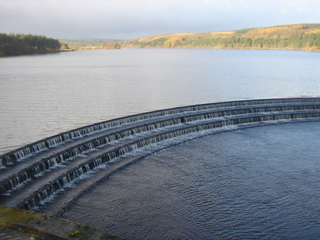
Fewston Reservoir is located in the Washburn valley north of Otley and west of Harrogate in Yorkshire, England. It was built in 1879. The capacity is about 3.5 million cubic metres. It can be found from the A59 road. The overflow from the reservoir feeds directly into the adjoining Swinsty Reservoir. Formerly, this overflow was encircled by a metal walkway from which floodboards could be lowered, but this has since been removed. The reservoir is the property of Yorkshire Water, which manages it for the benefit of walkers, anglers and wildlife. Situated in the charming Washburn valley, sharing an embankment with Swinsty Reservoir, Fewston is popular with walkers and runners. Cyclists and horse-riders can also make use of their own permitted tracks in the surrounding woodlands.

Swinsty Reservoir is a reservoir in the Washburn valley north of Otley and west of Harrogate in Yorkshire, England. Construction began in 1871 and was completed in 1878. The capacity is about 866 million gallons, with a surface area of 63 hectares. It can be found from the A59 road.

The Colsterdale towers are a set of sighting towers in and around Colsterdale, North Yorkshire, England.

Colsterdale is the valley of the River Burn, a tributary of the River Ure, in the Yorkshire Dales in North Yorkshire, England. It gives its name to a hamlet and civil parish in the upper part of the dale, about 7 miles (11 km) west of Masham. The population of the civil parish was estimated at 20 in 2010. The lower part of the dale around the hamlet of Gollinglith Foot is in the civil parish of Healey. The area is in Harrogate district.

Thomas Green & Son, Ltd. were engineers who manufactured a wide range of products at the Smithfield Foundry, Leeds, United Kingdom
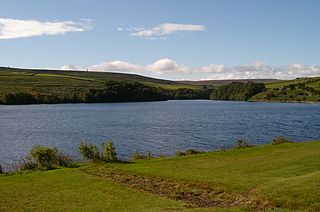
Leighton Reservoir is a reservoir which drains via the River Burn to the River Ure in North Yorkshire, England. It neighbours Roundhill Reservoir and is about 4 miles (6.4 km) west of Masham. It takes its name from the nearby village of Leighton.
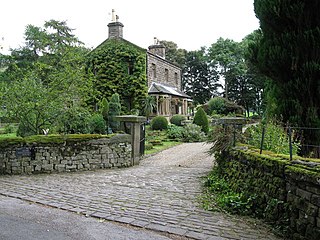
Nidd Valley Light Railway was a light railway in upper Nidderdale in the West Riding of Yorkshire, England. It was owned by Bradford Corporation Waterworks Department and the corporation also operated its public passenger services. Power & Traction Ltd of London obtained a Light Railway Order for the 6.5-mile (10.5 km) railway from Pateley Bridge to Lofthouse in 1900, but these powers were taken over by Bradford Corporation. A contract to build Angram Reservoir was awarded to John Best & Son in 1903, and he also won the contract to build the public railway and a 6.5-mile (10.5 km) private extension to the reservoir site. This was initially built to 3 ft gauge but was converted to standard gauge by 1907, when the public railway opened. Best had his own locomotives, and Bradford Corporation equipped the public railway with second hand locomotives and carriages from the Metropolitan Railway.
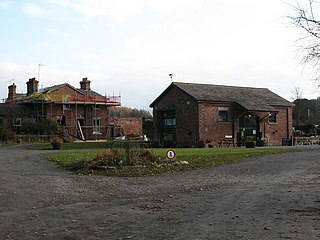
The Masham branch was a 7+3⁄4-mile (12.5 km) long North Eastern Railway built single track branch railway line that ran between a junction on the Harrogate to Northallerton line at Melmerby to Masham, North Yorkshire, via one intermediate station, Tanfield.

The River Burn is a river that flows wholly within North Yorkshire, England. The river starts as several small streams on Masham Moor and drains Colsterdale flowing eastwards before emptying into the River Ure just south of Masham. Conservation work on removing a weir, and introducing fish to the river in 2016, has meant that salmon have been recorded spawning in the river for the first time in over 100 years.

Masham railway station was the terminus of the Melmerby to Masham branch line serving the town of Masham in North Yorkshire, England. It was on the eastern side of the River Ure, so as such, was actually in Burton-on-Ure. The line operated between 1875 and 1931 for passenger traffic, but was retained for minimal freight train use until 1963.
Wath-in-Nidderdale railway station, was one of two intermediate stations on the Nidd Valley Light Railway, in Wath-in-Nidderdale, Yorkshire, England. The station was opened in September 1907, and closed to passengers in January 1930, however the line remained open until 1936 to transport freight to and from the reservoirs in the Upper Nidd Valley.

Upper Barden Reservoir is an upland fresh water reservoir, one of two reservoirs that collect water from Barden Moor, and dam Barden Beck, a tributary of the River Wharfe in the Yorkshire Dales, North Yorkshire, England. The reservoir was opened in 1882 and also supplies fresh water to the Nidd Aqueduct, which transports it to Bradford. Upper Barden Reservoir was the second of the reservoirs to be built,.
Lofthouse-in-Nidderdale railway station was the northernmost regular passenger terminus on the Nidd Valley Light Railway (NVLR), in Lofthouse, then in the West Riding of Yorkshire and now in North Yorkshire, England. The station was built as part of Bradford Corporation's programme of reservoir building in the Upper Nidd Valley. The station opened in 1904 and was closed to passengers in 1930. The station was renamed Lofthouse-in-Nidderdale railway station in 1907 to avoid confusion with Lofthouse and Outwood railway station, also in the West Riding of Yorkshire.
Pateley Bridge railway station (NVLR) was a railway station serving the southern terminus of the Nidd Valley Light Railway, in Pateley Bridge, North Yorkshire, England. The railway was built to enable the construction of reservoirs in the Upper Nidd Valley by the Bradford Corporation. The station opened to passengers in September 1907, and closed in January 1930, however, the adjacent line remained open for the transfer of goods traffic until 1937.
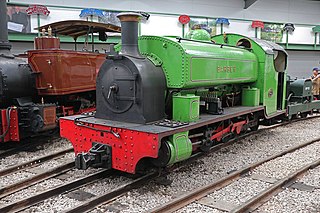
Harrogate Gasworks Railway was an industrial railway in the town of Harrogate, North Yorkshire, England. The line was a narrow gauge railway that ran between Bilton Junction on the Leeds and Thirsk Railway, to the Harrogate Gas Company's (HGC) works at New Park, north of the town centre. It opened in 1908 to carry inbound coal for gasification, and was closed to traffic in 1956. The railway was noted for its tight gauge restrictions in the tunnel through New Park. Two of its steam locomotives have survived into preservation, and are still in use on heritage railways.

















